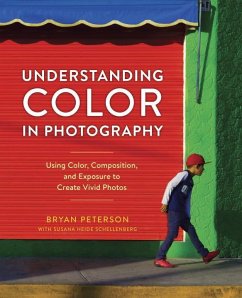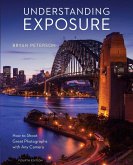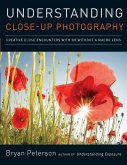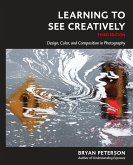B Peterson
Understanding Color in Photography: Using Color, Composition, and Exposure to Create Vivid Photos
B Peterson
Understanding Color in Photography: Using Color, Composition, and Exposure to Create Vivid Photos
- Broschiertes Buch
- Merkliste
- Auf die Merkliste
- Bewerten Bewerten
- Teilen
- Produkt teilen
- Produkterinnerung
- Produkterinnerung
Bryan Peterson, award-winning photographer and bestselling Amphoto author with almost 1 million books in print, demystifies the use of colour in digital photography, showing how to get stunning shots every time. Here Peterson explores his signature use of colour in photography, showing his process for creating striking images that pop off the page.
Andere Kunden interessierten sich auch für
![Understanding Exposure, Fourth Edition: How to Shoot Great Photographs with Any Camera Understanding Exposure, Fourth Edition: How to Shoot Great Photographs with Any Camera]() B PetersonUnderstanding Exposure, Fourth Edition: How to Shoot Great Photographs with Any Camera21,99 €
B PetersonUnderstanding Exposure, Fourth Edition: How to Shoot Great Photographs with Any Camera21,99 €![Understanding Close-up Photography Understanding Close-up Photography]() B PetersonUnderstanding Close-up Photography30,99 €
B PetersonUnderstanding Close-up Photography30,99 €![Langford's Starting Photography Langford's Starting Photography]() Philip AndrewsLangford's Starting Photography53,99 €
Philip AndrewsLangford's Starting Photography53,99 €![Extraordinary Everyday Photography Extraordinary Everyday Photography]() B TharpExtraordinary Everyday Photography30,99 €
B TharpExtraordinary Everyday Photography30,99 €![Studio Photography: Essential Skills Studio Photography: Essential Skills]() John ChildStudio Photography: Essential Skills8,99 €
John ChildStudio Photography: Essential Skills8,99 €![Learning to See Creatively, Third Edition Learning to See Creatively, Third Edition]() B PetersonLearning to See Creatively, Third Edition31,99 €
B PetersonLearning to See Creatively, Third Edition31,99 €![Hashtag Authentic Hashtag Authentic]() Sara TaskerHashtag Authentic24,99 €
Sara TaskerHashtag Authentic24,99 €-
-
-
Bryan Peterson, award-winning photographer and bestselling Amphoto author with almost 1 million books in print, demystifies the use of colour in digital photography, showing how to get stunning shots every time. Here Peterson explores his signature use of colour in photography, showing his process for creating striking images that pop off the page.
Hinweis: Dieser Artikel kann nur an eine deutsche Lieferadresse ausgeliefert werden.
Hinweis: Dieser Artikel kann nur an eine deutsche Lieferadresse ausgeliefert werden.
Produktdetails
- Produktdetails
- Verlag: Watson-Guptill Publications
- Seitenzahl: 144
- Erscheinungstermin: 29. August 2017
- Englisch
- Abmessung: 266mm x 217mm x 15mm
- Gewicht: 690g
- ISBN-13: 9780770433116
- ISBN-10: 0770433111
- Artikelnr.: 47704645
- Herstellerkennzeichnung
- Libri GmbH
- Europaallee 1
- 36244 Bad Hersfeld
- gpsr@libri.de
- Verlag: Watson-Guptill Publications
- Seitenzahl: 144
- Erscheinungstermin: 29. August 2017
- Englisch
- Abmessung: 266mm x 217mm x 15mm
- Gewicht: 690g
- ISBN-13: 9780770433116
- ISBN-10: 0770433111
- Artikelnr.: 47704645
- Herstellerkennzeichnung
- Libri GmbH
- Europaallee 1
- 36244 Bad Hersfeld
- gpsr@libri.de
BRYAN PETERSON is a professional photographer, internationally known instructor, and founder of The Perfect Picture School of Photography at PPSOP.com. He is also the best-selling author of Understanding Exposure, Learning to See Creatively, Understanding Digital Photography, Beyond Portraiture, and Bryan Peterson's Understanding Photography Field Guide. His trademark use of color and strong, graphic composition have garnered him many photographic awards, including the Art Director Club's Gold Award and honors from Communication Arts and Print magazines. Visit bryanfpeterson.com for more information.
Preliminary TOC
Introduction
Chapter 1: The Messages and Meanings of Color
How we understand and interpret color depends on many different things,
including culture, circumstances, and personal experience. This chapter
will explore different colors, their histories, and their cultural meanings
and messages, as well as a bit about the science behind how people see and
interpret color.
Chapter 2: Light, Exposure, and Color
When photographing, the two most important factors influencing the color in
your images are light and exposure. Color changes throughout the day,
depending on the quality and angle of light. This affects exposure and best
practices for capturing and conveying color in photography. This chapter
will explain how to photograph color in different light levels and
environments, depending on your desired end result.
Chapter 3: Color Theory
Color theory influences photography the same way it does conventional
artistic media. Clashing colors, bright and dull colors, and complementary
colors will all be explored, as well as recessive and aggressive colors.
This chapter will help you understand how to use color theory to create
compelling images.
Chapter 4: Color and Composition
Color can draw a viewer's eye to an image, conveying what the photographer
thinks is most important about a subject. It can also overwhelm, creating
visual chaos. Here we will explore how to use color in composition.
Chapter 5: Filters, Gels, and Flash
Filters, gels, and flash can all influence how color looks in our images.
You can either enhance or diminish the role of color in your compositions
using these tools, if you understand how they work. Here I will explain how
to use these elements to get the best images possible.
Chapter 6: Photoshop and the Post-Processing of Color in the Digital Age
Everyone nowadays is familiar with Photoshop, which can help you manipulate
color when all else fails in the field. Here I will explore how to use
Photoshop to process your color to get the desired end result, while also
discussing when to rely on this amazing tool, and when to rely on your own
skills with a camera.
Introduction
Chapter 1: The Messages and Meanings of Color
How we understand and interpret color depends on many different things,
including culture, circumstances, and personal experience. This chapter
will explore different colors, their histories, and their cultural meanings
and messages, as well as a bit about the science behind how people see and
interpret color.
Chapter 2: Light, Exposure, and Color
When photographing, the two most important factors influencing the color in
your images are light and exposure. Color changes throughout the day,
depending on the quality and angle of light. This affects exposure and best
practices for capturing and conveying color in photography. This chapter
will explain how to photograph color in different light levels and
environments, depending on your desired end result.
Chapter 3: Color Theory
Color theory influences photography the same way it does conventional
artistic media. Clashing colors, bright and dull colors, and complementary
colors will all be explored, as well as recessive and aggressive colors.
This chapter will help you understand how to use color theory to create
compelling images.
Chapter 4: Color and Composition
Color can draw a viewer's eye to an image, conveying what the photographer
thinks is most important about a subject. It can also overwhelm, creating
visual chaos. Here we will explore how to use color in composition.
Chapter 5: Filters, Gels, and Flash
Filters, gels, and flash can all influence how color looks in our images.
You can either enhance or diminish the role of color in your compositions
using these tools, if you understand how they work. Here I will explain how
to use these elements to get the best images possible.
Chapter 6: Photoshop and the Post-Processing of Color in the Digital Age
Everyone nowadays is familiar with Photoshop, which can help you manipulate
color when all else fails in the field. Here I will explore how to use
Photoshop to process your color to get the desired end result, while also
discussing when to rely on this amazing tool, and when to rely on your own
skills with a camera.
Preliminary TOC
Introduction
Chapter 1: The Messages and Meanings of Color
How we understand and interpret color depends on many different things,
including culture, circumstances, and personal experience. This chapter
will explore different colors, their histories, and their cultural meanings
and messages, as well as a bit about the science behind how people see and
interpret color.
Chapter 2: Light, Exposure, and Color
When photographing, the two most important factors influencing the color in
your images are light and exposure. Color changes throughout the day,
depending on the quality and angle of light. This affects exposure and best
practices for capturing and conveying color in photography. This chapter
will explain how to photograph color in different light levels and
environments, depending on your desired end result.
Chapter 3: Color Theory
Color theory influences photography the same way it does conventional
artistic media. Clashing colors, bright and dull colors, and complementary
colors will all be explored, as well as recessive and aggressive colors.
This chapter will help you understand how to use color theory to create
compelling images.
Chapter 4: Color and Composition
Color can draw a viewer's eye to an image, conveying what the photographer
thinks is most important about a subject. It can also overwhelm, creating
visual chaos. Here we will explore how to use color in composition.
Chapter 5: Filters, Gels, and Flash
Filters, gels, and flash can all influence how color looks in our images.
You can either enhance or diminish the role of color in your compositions
using these tools, if you understand how they work. Here I will explain how
to use these elements to get the best images possible.
Chapter 6: Photoshop and the Post-Processing of Color in the Digital Age
Everyone nowadays is familiar with Photoshop, which can help you manipulate
color when all else fails in the field. Here I will explore how to use
Photoshop to process your color to get the desired end result, while also
discussing when to rely on this amazing tool, and when to rely on your own
skills with a camera.
Introduction
Chapter 1: The Messages and Meanings of Color
How we understand and interpret color depends on many different things,
including culture, circumstances, and personal experience. This chapter
will explore different colors, their histories, and their cultural meanings
and messages, as well as a bit about the science behind how people see and
interpret color.
Chapter 2: Light, Exposure, and Color
When photographing, the two most important factors influencing the color in
your images are light and exposure. Color changes throughout the day,
depending on the quality and angle of light. This affects exposure and best
practices for capturing and conveying color in photography. This chapter
will explain how to photograph color in different light levels and
environments, depending on your desired end result.
Chapter 3: Color Theory
Color theory influences photography the same way it does conventional
artistic media. Clashing colors, bright and dull colors, and complementary
colors will all be explored, as well as recessive and aggressive colors.
This chapter will help you understand how to use color theory to create
compelling images.
Chapter 4: Color and Composition
Color can draw a viewer's eye to an image, conveying what the photographer
thinks is most important about a subject. It can also overwhelm, creating
visual chaos. Here we will explore how to use color in composition.
Chapter 5: Filters, Gels, and Flash
Filters, gels, and flash can all influence how color looks in our images.
You can either enhance or diminish the role of color in your compositions
using these tools, if you understand how they work. Here I will explain how
to use these elements to get the best images possible.
Chapter 6: Photoshop and the Post-Processing of Color in the Digital Age
Everyone nowadays is familiar with Photoshop, which can help you manipulate
color when all else fails in the field. Here I will explore how to use
Photoshop to process your color to get the desired end result, while also
discussing when to rely on this amazing tool, and when to rely on your own
skills with a camera.








